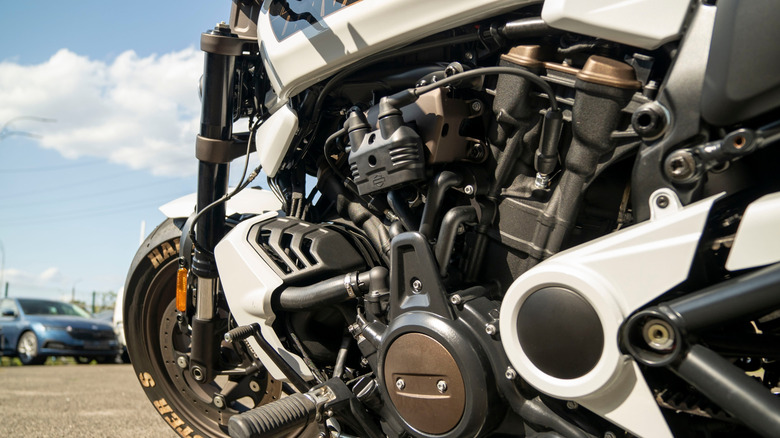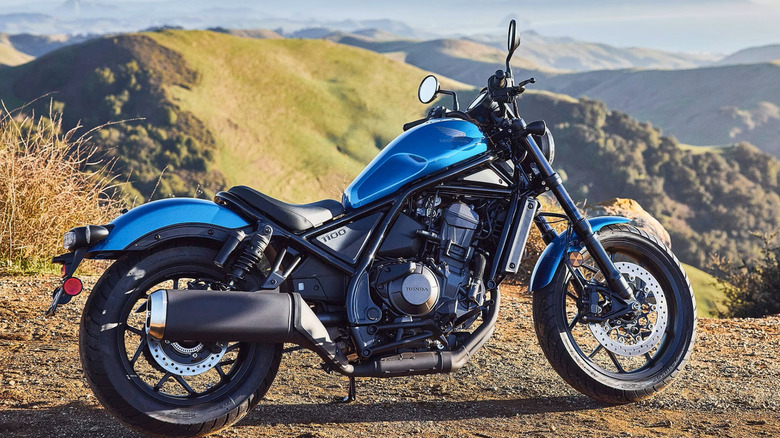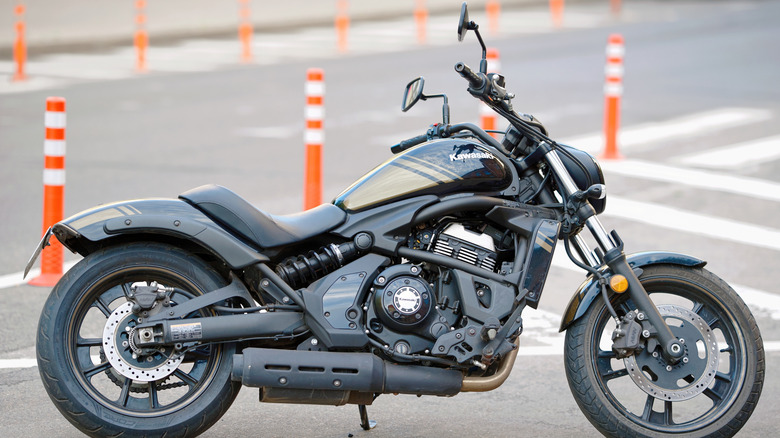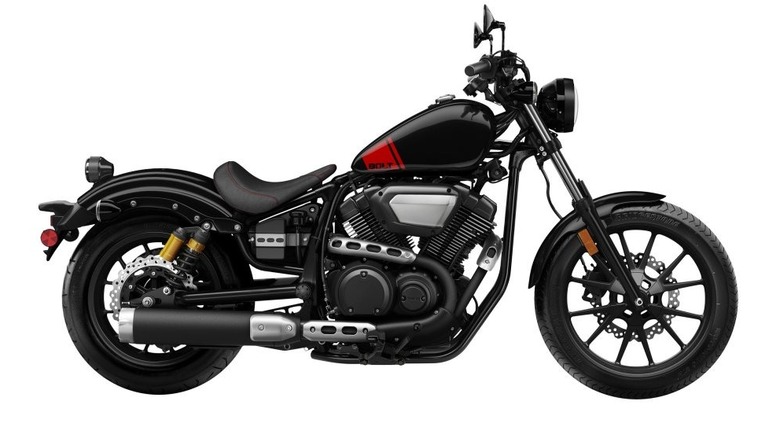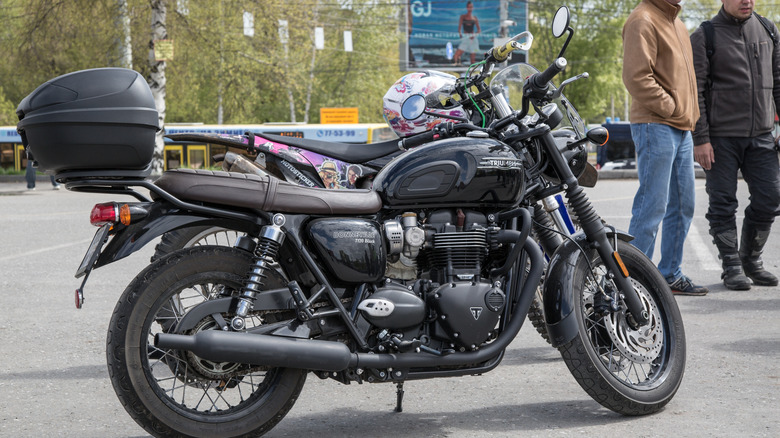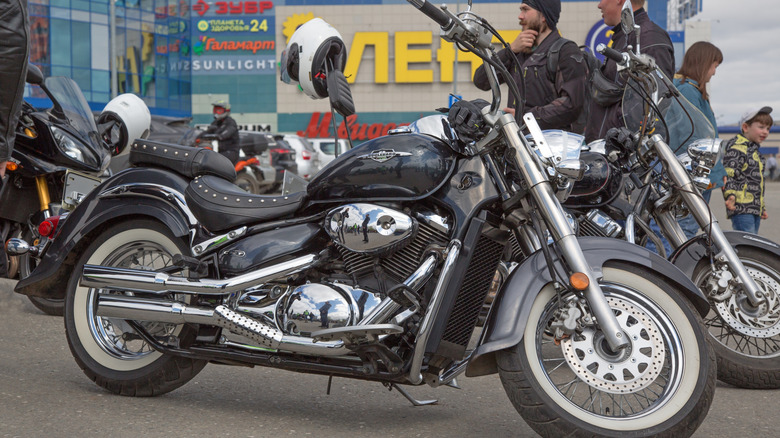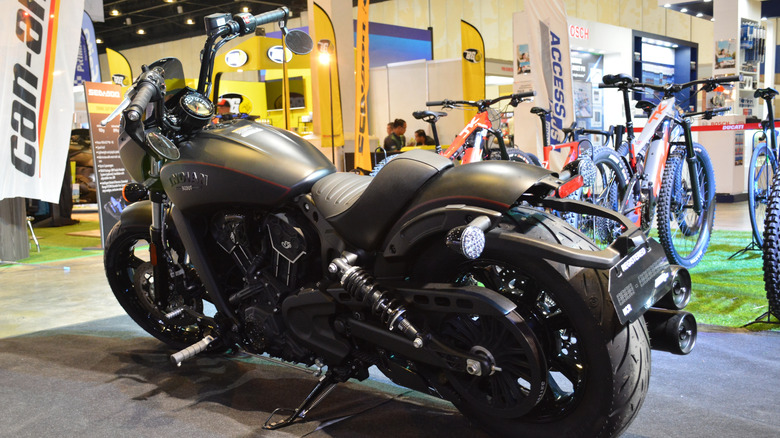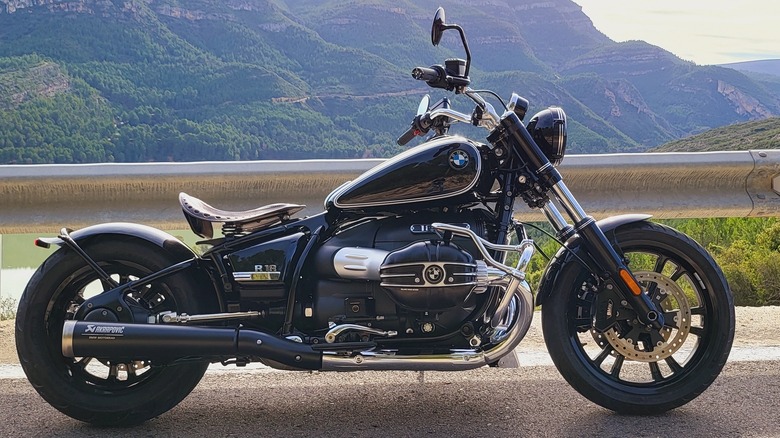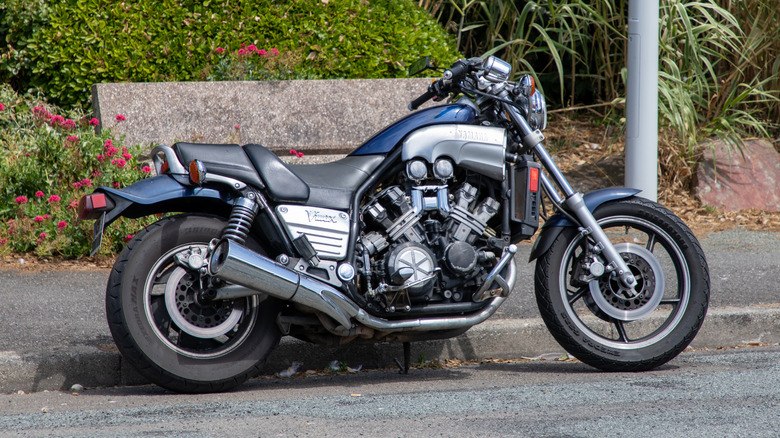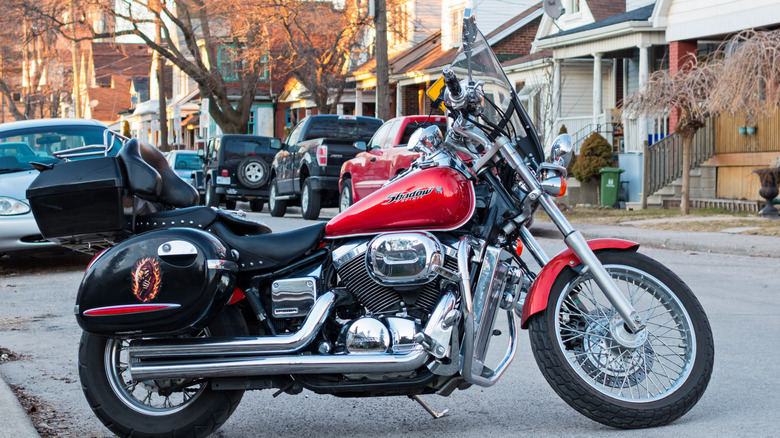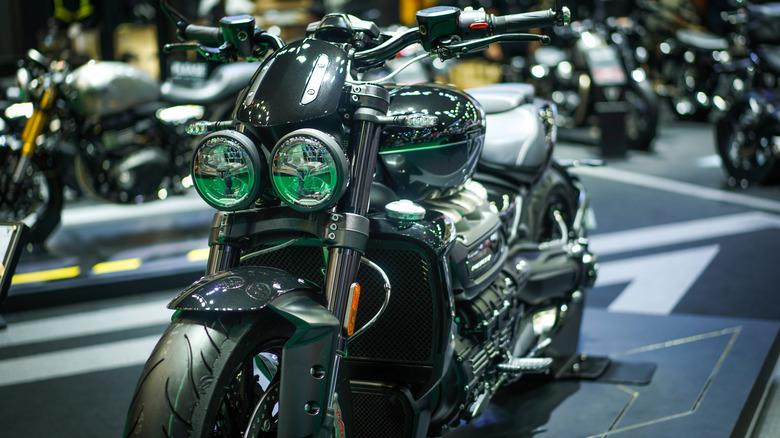10 Alternatives To The Harley-Davidson Sportster
It truly is a golden age for motorcyclists. The art of motorcycle riding is widely practiced, and the average consumer has every conceivable type of motorcycle at their fingertips. Whether it's a dirty dual-sport or a show-ready chrome statue, there's a bike for everyone out there. Today, we will scrutinize the middleweight cruiser category for alternatives to the Harley-Davidson Sportster.
The Sportster is legendary. Everyone knows it. Spawned in 1957, it has seen many motorcycle trends come and go. V-twin power delivery from some of the best engines in Harley Davidson history earned it a stalwart fan base. The Sportster has carved such a name that others follow its path.
Fortunately for us consumers, nearly every major bike producer — from Japan, Germany, the U.K., and beyond — makes a motorcycle that can do what the Sportster does. Let's look at some of the best bikes for scratching that Sportster itch. Some may be less expensive than the Sportster, while others are far more, but each one is a serious contender in the competition for the king of the cruiser middleweight.
Honda Rebel 1100
Honda is an excellent motorcycle producer. The corporation has built some of the most successful motorcycles in the world. It offers something in virtually every class on the market, from superbikes to motocross. And Honda's most recent entry into the middleweight cruiser is a worthy challenger to the Sportster's title.
The Rebel 1100 truly looks the part. It is low-slung, dark, and looks ready to gobble up a canyon. At a glance, it looks like a Sportster clone, but up close, you'll notice a parallel-twin engine where a Sportster would stow a V-twin. It signals that Honda is more into you enjoying this motorcycle than replicating the Sportster experience. The V-twin delivery is such a part of the Harley experience, but without it, we are left with, frankly, a fun, stylish, and powerful motorcycle.
The Rebel 1100 comes with Honda Dual-Clutch Technology (DCT). Honda brags about its effectiveness and convenience, but some bikers will think any automatic transmission on a motorcycle is anathema. It could prove helpful for beginner bikers, and anything that grows the sport is welcome.
In manual or DCT mode, the Rebel 1100 is Honda's best entry to the middleweight cruiser category, and it could give any Sportster a run for its money. If a modern middleweight is on the wish list, but a Harley budget is not part of the equation, the Rebel 1100 may be the answer. Honda and Harley have tangled before; when they do, it is usually for the consumer's benefit.
Kawasaki Vulcan S
The Kawasaki Vulcan has been a cog in Kawasaki's wheel since the Vulcan 750 introduced the company's first-ever V-twin in 1984. Since then, the Vulcan has worn many hats at Kawasaki, and many of them would fit nicely on the head of one searching for a Sportster alternative.
The latest iteration of the Vulcan to aim at the Sportster is the Vulcan S. Most Sportsters have 883cc or 1200cc V-twin engines. The Vulcan S uses a 649cc parallel-twin. While it won't create the power of a Harley in the way the Rebel 1100 can, it offers an excellent platform for beginners who wish to get into cruising.
The Vulcan S is a comfortable, everyday commuter or weekend rider. Kawasaki points out its focus on the rider's ergonomic experience. This is meant to be a comfortable motorcycle that cruises with minimum fuss.
This is not the only iteration of the Vulcan. Kawasaki has been building the line for 40 years. The Vulcan nameplate has adorned everything from full-baggers to Sportster destroyers. The Vulcan line goes way back; it may have some deep picks.
Yamaha Bolt R-Spec
Yamaha knows serious performance. Since the inception of the YZF-R1 in 1998, Yamaha's R-series badge has become one of the most respected in motorcycling. The Yamaha Bolt R-Spec is a little different. Instead of a super sleek road racer, we have a low-slung cruiser. Unlike some bikes on this list, the Bolt employs a true V-twin engine. Though Harley-Davidson tried to sue anyone who copied its trademark sound, it couldn't stop builders from using the V-twin configuration it helped popularize.
It is hard to deny the allure of the V-twin. It just hits differently, creating torque in all the right places. The Bolt R-Spec wants to be a Harley so badly Yamaha even lists its displacement at 942cc. Nearly 1,000cc in something Yamaha deems worthy of its R-badge should make any cruiser fan's head perk up. This bike is in direct competition with the likes of the Vulcan, so much so that we wrote up the differences between the two.
The V-twin is also air-cooled, which is the biggest nod a modern competitor can offer Harley. This thing wants to be a Sportster as much as anything on this list. An unpracticed eye might think it a Sportster as it whizzes down a twisty road, but you'll know you paid the truth but will be having too much fun to care.
Triumph Bonneville
The Triumph Bonneville is not likely to be confused with a Sportster. Just the same, it is a major player in the middleweight cruiser scene. Coming from a legacy of cafe racing, Triumph has seen ups and downs as a company, first gaining fame in the 1960s and 1970s before struggling, only to reemerge with a vengeance.
The Bonneville is the British builder's biggest Sportster competitor. The Bonnie is a classic from the cafe days, and it comes in a few flavors today. There is something for everyone between the Speedmaster, T120, Bobber, and T100.
The Bonneville uses the parallel-twin configuration in 1,200cc and 1,000cc volumes. The T120 is perhaps the leader of the lot. It certainly has a style all its own, and it does not need to copy a Sportster's looks. Triumph has its own rich legacy on which to depend.
For fans of British bike building who want to keep up with buddies on the Sunday ride, a Bonneville should be on the list. Think of it as a restomod project that you don't have to build yourself. Triumph's most famous bike has been back in production since 2001, and offers an exciting twist on the middleweight cruiser competition.
Suzuki Boulevard
Suzuki has perhaps the most extensive motorcycle lineup, alongside Honda, Kawasaki, and Yamaha. The industrial conglomerate seems to make something for everyone, but the backbone of its cruiser segment is the Suzuki Boulevard.
The Boulevard has been floating around Suzuki's cruiser category for 20 years. The 2004 Boulevard S40 debuted as the first cruiser motorcycle manufactured by Suzuki. Like the Vulcan, the Boulevard has filled many roles in its time, but most have been as a V-twin town cruiser, sometimes with bags and windscreens, sometimes without.
There are two Boulevards in Suzuki's modern lineup, and they should absolutely not be confused. The first is the Boulevard C50, an 805cc 45-degree V-twin with a low saddle akin to a Harley-Davidson Sportster 883. The other Boulevard variants, nicknamed the M109R and M109R B.O.S.S., are as muscular as the name implies. The M109R option more than doubles displacement with a 1783cc 54-degree V-twin. Two very different motorcycles named Boulevard.
Whichever one you prefer, it is clear that this is Suzuki's entry in the middleweight cruiser competition. With a legendary race pedigree and a long history of producing motorcycles, underestimating Suzuki may be a big mistake.
Indian Scout
The Harley-Davidson and Indian motorcycle companies once fought a war for the heart of American motorcycling. By hook or by crook, Harley won and Indian shuttered its factories in 1953. However, no doubt to Harley's horror, the old enemy rose from the grave when Polaris resurrected the nameplate in 2011. Like a zombie, Indian returned, but instead of brains, it hungers for Harley's motorcycle market share. That includes a middleweight cruiser in the form of the Indian Scout.
While Japanese builders throw a bike at the cruiser world and go back to their MotoGP teams, Indian has made the V-twin fight its main event. The Indian Scout and Indian Chief are the Sportster competitors in Indian's lineup.
Indian is the most unabashedly American bike builder on this list. The bikes are handsome, powerful, and stuffed with V-twin goodness. The Sport Chief might be out of the Sportster comparison, as its price tag runs a little hot at $19,999. But the Scout is undoubtedly in the same range as a Sportster.
A 1205cc liquid-cooled V-twin makes 105 hp for $12,999, and the Scout looks every bit as muscular as those numbers suggest. It is low and lean and featured in Indian's photos with a solo seat set up. It is made to appeal to the romanticism in motorcycling, and it does so with unmistakable style.
BMW R 18
BMW is not usually the first name that comes to mind when developing a list of Harley-Davidson competitors. But it seems the German automaker likes to poke into other sectors to warn competitors that it could disrupt the market should it choose. As ominous as that attitude is, it produced an exciting concept in the R18.
The R18 is essentially BMW's Harley-Davidson. A swept-back cruiser with a 1,802cc boxer engine that sticks out of the side like wings, the R18 smashed into BMW's lineup in 2020, relying on its BMW backing to raise an eyebrow or two, and it succeeded in that. The R18 is both a tremendous motorcycle and a work of art. It expresses a vintage BMW feel. It looks like what Indiana Jones would ride to escape the children from The Sound of Music.
The R 18 may be beautiful, but she is a certified grunter with 91 hp and 116 lb-ft of torque. Twin disc 300-millimeter four-piston brakes in the front and a single 300-millimeter four-piston disc in the back bring the 761-pound motorcycle to a stop. But the R-18 isn't supposed to be pulled to a violent stop. It is supposed to glide beautifully and make a statement, which it certainly does.
You won't see many parked outside the honky tonk motorcycle bars of America, but the new BMW R 18 may grab the eye of a Sportster lover with a Europhile flair.
Yamaha V-Max
Eyeing the Sportster because you are stepping off a sportbike? Don't make a common mistake. If you've been thrashing a 600cc or 1,000cc sportbike, but want to slip into something a little more comfortable, Yamaha's discontinued V-Max is a diamond in the rough.
Like the Vulcan and the Boulevard, the V-Max had a long career in Yamaha's lineup. Unlike the Boulevard and Vulcan, the V-Max actually had a well-defined role in the line — it was the muscle car to everyone else's sports car.
Yamaha fired the V-Max at the American market like a warning shot. The 1,197cc shaft-driven V4 made 145 hp — a power level that wasn't available in Japan. It instantly grabbed the market, and held on until 2020, leaving plenty of powerful muscle bikes littering the used market.
Over three generations, the V-Max provided riders with thunderous performance, a truly head-turning sound, and enough power to smoke some superbikes (there's always someone faster). The best thing about it is how Yamaha wrapped it up in an aggressively stanced chrome package that was sure to catch the eye of Sportster lovers. By the time the V-Max went out of production in 2020, Yamaha was stuffing it with a 1,679cc V4, which made a reported 173 hp.
Honda Shadow
Though Honda has allowed the new Rebel to be its own thing, Honda fought for the Sportster's market share for decades by wielding the vaunted Shadow. In 1983, Honda launched a low, light V-twin cruiser called the CVT500C Shadow. It was the beginning of a fierce battle.
The very design of the Shadow puts it squarely in the Sportster market. Harleys can be expensive. Mass-produced Hondas aren't necessarily so. The Shadow was a great bike to learn on, easy on the wallet, and felt enough like a Harley from behind the handlebars for it not to matter.
Over the years, the Shadow got bigger displacements and new designations, but it stuck with that V-twin in a 1,100cc or 750cc configuration. People who didn't want to pay the premium for the Harley nameplate scooped them up by the thousands, and Honda kept making them deep into the 2010s.
If electric doesn't completely take over, the Honda Shadow will continue to be the bike kids pull out of their uncle's garage to pick up. In all shapes and sizes, the Shadow might not be in production anymore, but that won't stop it from competing with the Sportster for a long time.
Triumph Rocket 3 Storm
Triumph isn't just rehashing old favorites. The resurrected company dabbles in an often ignored space: the triple-cylinder engine. The Triumph Rocket 3 Storm dares to be a triple-cylinder road machine with enormous displacement and fantastic power.
Triumph offers the Rockets in a handful of configurations, all floating around the $25,000 mark. While that price tag won't be compared favorably with the Sportster's, the bike won't be mistaken for a Sportster in all the best ways. Distinctive and muscular styling, three fat exhaust pipes sticking out of the side. The Rocket 3 is the sort of bike that gathers a crowd of curious onlookers with a Sportster at home.
With a 2,458cc in-line three-cylinder engine making 179 horsepower and 166 lb-ft of torque, the Rocket 3 Storm is no slouch. That is V-Max level power with one fewer cylinder. Talk about unique power delivery. The Rocket 3 is why we're glad some manufacturers get a second chance. Since it rose from the grave, Triumph has kept the interesting bikes coming.
